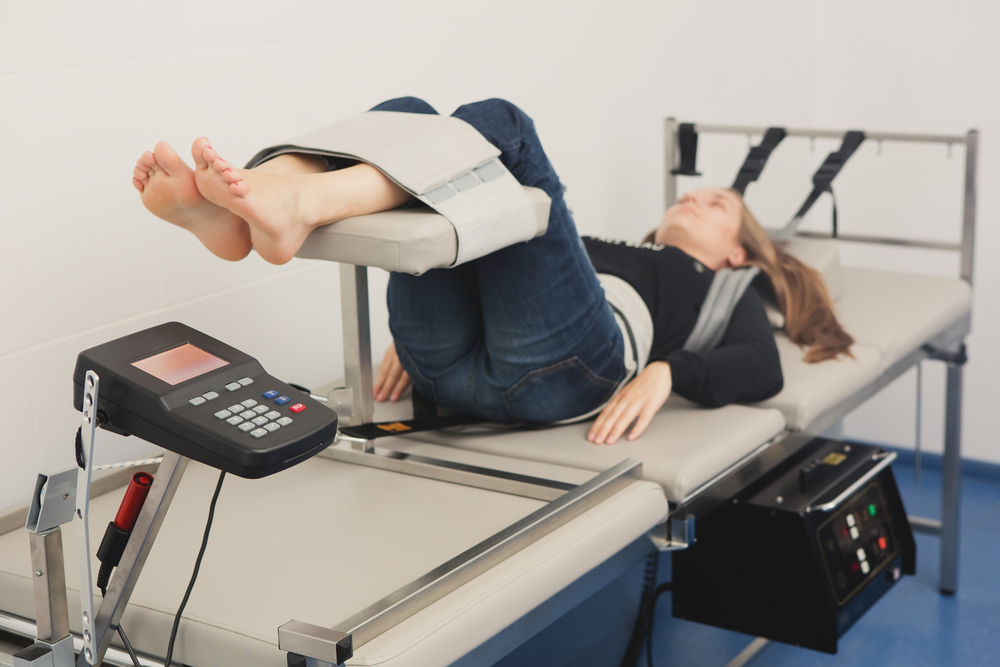Spinal Decompression San Clemente CA
All About Spinal Decompression Therapy
Do you experience unexplained aches in different parts of the body? Is it difficult for you to maintain a balanced posture? Is your natural range of motion limited in any way? If your answer to any of these questions is in the affirmative, it may point towards an underlying problem – misalignment of spine.
Defining Spinal Misalignment
Habitual inappropriate posture can lead to spinal misalignment. This is the situation in which your spinal column adheres to the “new” normal, losing its original shape. This may give rise to stress and/or damage to the spinal cord, which in turn leads to aches, restricted mobility and other similar problems. When the nerves running along the spinal column are stressed, it generally surfaces in the form of pain in different parts of the body.
Spinal Decompression Therapy
The spinal decompression therapy entails rectification of the spinal misalignment through physical and/or mechanical manipulations. It is one of the most important techniques used by medical practitioners and chiropractors to address pain-related problems.
It is of two types – surgical and non-surgical spinal decompression therapy. As the name suggests, they differ in the mode of administration. Here’s a little insight about each.
Non-Surgical Spinal Decompression Therapy
This mode of treatment entails stretching of the spinal column into its original structure. Physical pressure is applied – either by hand or by mechanical tools – to alter the shape and position of the spinal column. This relieves the unnecessary stress being applied on the enclosed spinal cord. It also relieves the pressure on the nerve cells lining the spinal column, helping you feel at ease.
It is a non-invasive technique and may require several sessions before a positive difference is felt. It is considered to be quite effective in tackling back pains, neck pains, herniated discs, spinal injuries and others. However, people with preexisting conditions like fracture, tumor, osteoporosis, and metal implants are advised not to pursue non-surgical spinal decompression therapy.
Non-surgical spinal decompression therapy is usually followed up by complementary treatments like electrical stimulation, ultrasound therapy or heat/cold therapies.

When Should You Consider the Spinal Decompression Option?
To answer this, let’s consider two arguments.
First, if you are being seen by an orthopedic or spine specialist, you will almost always be administered a traditional program as related to your particular problem. In basic terms, he will perform diagnostics using x-rays, ultrasounds, or MRI to form his conclusion about your condition; then he will prescribe pain killers, initiate epidural shots in the problem area, or suggest back surgery. However, these doctors will almost never recommend or suggest Spinal Decompression. There are perhaps many pros and cons regarding this approach which suggests that it is either not very lucrative for them, or there are still differences of opinion as to the validity of such a method yielding reliable or safe results.
Secondly, there are medical professionals who actually practice the art of administering Spinal Decompression using “inversion therapy” under controlled conditions (intermittent stretching). Although inversion therapy has been around for a long time, technology has only recently yielded modern inversion equipment and facilities, and there are now specialty medical personnel willing to set up shop for this service. It is recommended that anyone considering an inversion or spinal decompression approach, first consult with your spine doctor to determine if you are a candidate, based on certain body limitations and restrictive conditions that may not be in your best interest. Keep in mind that many health insurance programs may not cover such professional services.
Choosing to pursue a self-administered decompression option can be a personal choice but it may come with risks. A person must realize whether his physical condition is capable of supporting repetitive stretching of his spine and other body parts when using for example a commercially available “Inversion Table” or other available back stretchers such as the Nubax Trio. Many stores such as Wal-Mart and Sporting Outlets sell inversion equipment but the “buyer beware” slogan is always implied. It is recommended that you purchase a quality inversion table such as the Teeter Hangups. Common sense should dictate whether such a purchase meets your needs without harming your body. Another factor to consider is your age. Most persons who are physically fit and well-conditioned in their early years will probably coast through a decompression session without adverse effects. This may not fare so well with older folks who lack the stamina and well-being necessary to meet the challenge.
You are probably one of many back pain sufferers who will be advised, by those who have “been there done that”, not to agree on back surgery because spinal decompression may very well relieve your symptoms and eradicate your problem. For those not wanting to seek chiropractic or physical therapy help for their back pain, consider a low-scale low-impact decompression home exercise program using the Nubax Trio stretching device. Most medical back-pain personnel will emphasize the importance of supplementing back stretching with strengthening one’s core and back muscles that support the spinal column. Many people have discovered their back pain gone or reduced after following a routine home decompression program along with other stretching and strengthening exercises.
Frequently Asked Questions
Spinal Decompression - Does Spinal Decompression Work?
Anyone who has been through an injury involving their spinal column knows and understands how painful and difficult it can be to try to recover from the injury. A damaged spine can cause excruciating back pain, neck pain, headaches, even referred pain that is felt in the feet or hands. The spinal column is essentially the control center of the nerve sensations for the human body. with its extensive nerve network, back discs, neck discs, and joints, there are a number of different things that can go wrong with the spine – especially if you have been in an accident or have a chronic condition like arthritis.
You may have heard about non-surgical spinal decompression, which is a therapy method in the chiropractic vein: All chiropractic therapies are completely non-invasive and all natural. A therapy like non-surgical spinal decompression will never require invasive surgery, prescription medications, or dangerous procedures.
Chiropractic therapy methods like spinal decompression are holistic – all natural healing. Since it is not always well understood, we will be explaining more about spinal decompression and whether it is could be an effective therapy for your case in this article.
Does this treatment work?
Spinal decompression works by gently pulling apart the nerves and discs that are compacted in the spinal column (and are therefore causing the pain.) Pinched nerves and compacted discs are some of the most common injuries involving the back and the neck, and the goal of non-surgical spinal decompression is to resolve this problem. This is accomplished via a non-surgical traction machine.
The patient will be comfortably strapped onto a specially designed chiropractic table, and the straps will then be attached to the machine. The chiropractor will adjust the traction device, an entirely computerized process that is customized for each patient, to apply a very gentle type of vacuum pressure. During therapy, the damaged nerves and discs will be separated and then returned to their proper places in the spinal column.
Once the non-surgical spinal decompression therapy is completed, which can take anywhere from one visit to a short series of visits, the spine will be in proper alignment. When the spine is properly aligned, all the pressure that was causing the pain will be gone – which results in pain relief.
This type of non-surgical therapy is extremely effective because it allows for the proper re-ordering of a damaged spinal column. No amount of medication can accomplish what spinal decompression can do! Medication is often prescribed to relieve pain, but this is a temporary solution and the pain will return as soon as the medication has worn off. Non-surgical spinal decompression therapy actually removes the problem at its origins. For this reason, it is generally considered to be one of the most effective and gentle ways to resolve pain for patients who want to pursue all natural healing methods.
Does it work?
The answer is a definitive “Yes” for nearly all people who have tried this, especially when they compare it to other therapies that are only short term solutions. Non surgical spinal decompression can be a long term solution for back pain, neck pain, and chronic pain conditions of all types.
Nearby Cities:
